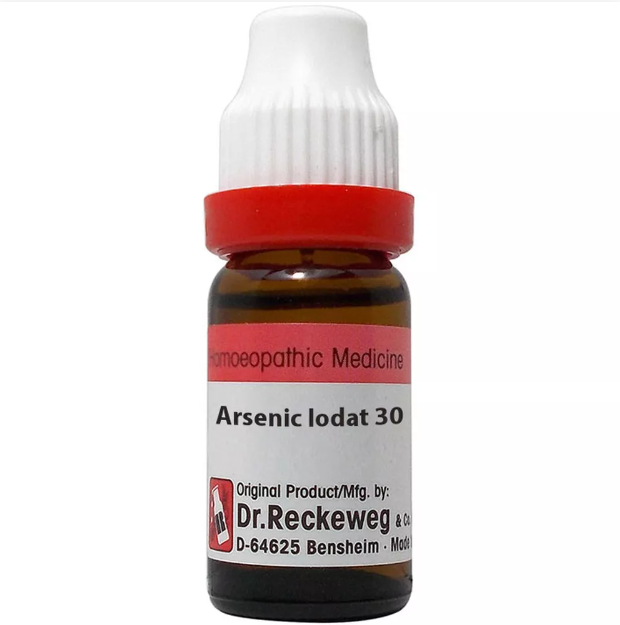ARSENICUM IODATUM Q, 6C, 12C, 30C, 200C, 1M, 10M USES AND SYMPTOMS
 Arsenicum Iodatum
Arsenicum Iodatum
(Ars-i.)
Characterized by persistently irritating, corrosive discharges that inflame membranes. The discharge is often fetid and watery, with a red, swollen, itchy, and burning mucous membrane. This remedy is effective for various conditions including influenza, hay fever, chronic nasal catarrhs, and middle ear catarrh. It’s also useful for swollen nasal tissues, hypertrophy of the eustachian tube, senile heart, myocarditis, and fatty degeneration. Other symptoms include a shotty pulse, chronic aortitis, lip epithelioma, and ulcerated breast cancer. In early tuberculosis stages, it helps with profound prostration, rapid pulse, fever, sweats, emaciation, and diarrhea tendency. It also addresses hoarse cough, purulent expectoration, cardiac weakness, emaciation, chronic diarrhea, amenorrhea with palpitations, and dyspnea. Additionally, it’s beneficial for chronic pneumonia, lung abscess, hectic fever, and night sweats.
In terms of specific symptoms:
Head: Vertigo and tremulous feeling in the aged.
Eyes: Scrofulous ophthalmia.
Ears: Otitis media, fetid otorrhea, and thickening of the tympanum.
Nose: Watery, irritating discharge, sneezing, hay fever, chronic catarrh, swollen nose, ulcers, and excoriated membrane.
Throat: Burning sensation, swollen tonsils, fetid breath, diphtheria, and chronic pharyngitis.
Stomach: Pain, pyrosis, vomiting after food, nausea, epigastric pain, and intense thirst.
Respiratory: Dry cough, stopped nostrils, pleurisy, chronic bronchitis, pulmonary tuberculosis, pneumonia, and aphonia.
Fever: Recurrent fever, night sweats, rapid, feeble pulse, and chilliness.
Skin: Dry, itchy, and scaly skin with large-scale exfoliation, scrofulous glands, venereal bubo, eczema, emaciation, psoriasis, and acne.
Relationship: It compares to Tuberculinum and Antimonium Iodatum. In hay fever, it can be compared to Aralia, Naphtinum, Rosa, and Sangunaria nitrica.
Dose: 2nd and 3rd trituration, starting with 4x and gradually decreasing to 2x trituration, 5 grains, thrice daily for tuberculosis. It should be prepared fresh and protected from light.
SYMPTOMS OF ARSENICUM IODATUM
Persistent, Corrosive Discharges: Irritating, fetid, watery discharges that inflame membranes.
Mucous Membrane Irritation: Always red, swollen, itchy, burning.
Conditions: Influenza, hay fever, chronic nasal catarrhs, middle ear catarrh.
Nasal Symptoms: Swelling, discharge, sneezing, chronic irritation.
Ear Symptoms: Otitis media, fetid discharge, thickening.
Throat Afflictions: Burning, swollen tonsils, foul breath, chronic pharyngitis.
Digestive Issues: Pain, vomiting after eating, intense thirst.
Respiratory Problems: Dry cough, pleurisy, bronchitis, tuberculosis, pneumonia.
Fever and Sweats: Recurrent fever, night sweats, rapid pulse, chilliness.
Skin Manifestations: Dry, itchy, scaly, large-scale exfoliation, eczema, acne, emaciation.
Relationships: Comparison with Tub., Ant-i., and other remedies for hay fever.
Dosage: 2nd and 3rd trituration, gradually decreasing for tuberculosis treatment.
selection of the potency
Individualization:
- Homeopathy is based on the principle of treating the individual, not just the disease. The unique symptoms and characteristics of the person are crucial in determining the most suitable potency.
Intensity of Symptoms:
- The intensity of the symptoms guides the choice of potency. If the symptoms are intense and acute, a lower potency (e.g., 6C, 30C) might be considered. For chronic conditions with less intensity, higher potencies (e.g., 200C, 1M) may be appropriate.
Sensitivity of the Patient:
- Some individuals are more sensitive to homeopathic remedies, while others may require higher potencies. The practitioner considers the patient’s sensitivity when selecting the potency.
Acute vs. Chronic Conditions:
- Lower potencies are often used for acute conditions, while higher potencies may be considered for chronic or long-standing issues.
Previous Response to Potencies:
- The patient’s response to previous homeopathic treatments helps guide the choice of potency. If a particular potency has been effective in the past, it may be repeated or adjusted as needed.
Vital Force and Susceptibility:
- Homeopathy views illness as a disturbance in the vital force. The practitioner assesses the patient’s overall vitality and susceptibility to determine the appropriate potency.
Aggravation or Amelioration:
- The direction of the symptom response (aggravation or amelioration) after taking a remedy can influence the choice of potency.
Miasmatic Considerations:
- In classical homeopathy, the concept of miasms (inherited disease tendencies) is considered. The practitioner take this into account when selecting the potency.
Practitioner Experience:
- The experience and preference of the homeopathic practitioner play a role. Some practitioners may have success with certain potencies based on their clinical experience.
SAFETY INFORMATION
- Do not exceed the recommended dose by physician
- Keep out of the reach of children
- Store in a cool dry place away from direct sunlight
- Maintain half an hour gap between food/drink/any other medicines and homoeopathic medicine
- Avoid any strong smell in the mouth while taking medicine e.g. camphor, garlic, onion, coffee, hing
Medicine images use for reference only selection of homeopathic medicine depends on the individual’s specific symptoms and overall constitution. Moreover, homeopathy is a holistic system of medicine that treats the individual as a whole. In addition to addressing the physical symptoms, it takes into account the emotional and mental state of the person. Consequently, it’s crucial to consult with a qualified homeopathic practitioner for personalized treatment.
The information provided on this website is intended solely for educational purposes. Always seek the advice of your physician or other qualified health provider.
